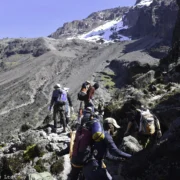How To Treat, Recognize and avoid Hypothermia
Hydration, nutrition, proper clothing, layering and good rest management are all key to preventing hypothermia. Learn how to prevent, recognize, and treat this backcountry threat.
Cool to cold temperatures, light precipitation, exposure to wind, extended time outside. It sounds just like a fall or winter hike in the Cascades! Unfortunately, these descriptors also characterize ideal conditions for hypothermia.

Hypothermia is a fairly common condition for mountain travelers. Mild hypothermia is a discomfort, but it’s dangerous in that it can progress rapidly. Left untreated, it can be lead to shock and it can be fatal. It’s important to know how to prevent hypothermia, how to identify if someone is hypothermic, and how to treat that person.
As a mountain guide, I focus most of my efforts against hypothermia in the prevention stage. Like dehydration, it’s much easier either to not allow it to happen, or to catch it early.
TO UNDERSTAND PREVENTION, IT’S BEST TO KNOW WHAT CAUSES HYPOTHERMIA:
- Inadequate protection from exposure
- Lack of proper hydration and nutrition
- Improper planning for the activity or the conditions
When one is out exercising in cool weather, if the exercise rate is high enough and breaks are short, the body will keep itself warm (provided there is enough fuel and water on board). But down time due to unexpected delays, extended time out due to conditions or human factors, and lack of extra food and clothing are common situations that heighten risk of exposure. Hypothermia is often a secondary problem that arises after a separate issue, such as a twisted ankle or busted gear.
Look at the weather forecast and plan accordingly. Regardless of the forecast, if you will be in mountainous terrain, having extra layers, food and water is always a good idea. I carry a very lightweight bivy sack as well. It only takes up little space, but could be a lifesaver.
If someone in your group ends up with serious hypothermia, it’s a true “stop and fix” situation. Unfortunately, in doing so you are putting more of the group at risk due to extended exposure to the same conditions. Picture a group huddled around a team member in the cold rain, on a windy mountain ridge with fading light. Always remember that for the hiker, prevention is your first line of defense against hypothermia.
PREVENTATIVE STEPS
- Hydration and nutrition. Have extra snacks and water, and keep them handy.
- Proper clothing. Remember that “cotton kills.” When you might run into rain or snow, it’s best to wear synthetic materials or wool, which, unlike cotton, can keep you warm even when wet.
- Proper layering. Know how and when to make adjustments.
- Good rest management. Pick rest stops that are sheltered, encourage eating and hydration at each stop, but keep break times short.
Despite good planning, sometimes the best intentions don’t pan out. Or, you may come across a hiker from another party who you may suspect is in trouble. What are the signs to look for?
SIGNS AND SYMPTOMS OF MILD HYPOTHERMIA
- The “Umbles”: stumbles, mumbles, grumbles, fumbles
- Shivering
- Changes in personality, especially quiet
- Body temperature that is lower than normal, but usually above 90 to 92 degrees F
SIGNS AND SYMPTOMS OF SEVERE HYPOTHERMIA
- Body temperature below 90 degrees F
- No longer shivering, severe lack of coordination
- Incoherence
- Paradoxical undressing
TREATMENT OF MILD HYPOTHERMIA
- Get out of areas of exposure
- Add insulating clothing layers
- Replace wet base layers with dry ones
- Exercise in short bursts to generate heat
- Treat dehydration and ensure that adequate energy is on board
TREATMENT OF SEVERE HYPOTHERMIA
- A severely hypothermic patient is in a critical situation. Due to the potential for ventricular fibrillation, they must be treated very carefully. The best treatment involves protection from the elements and rewarming on the spot.
Recent Posts
Mount Kenya Challenge Program
Mount Mtelo Sekerr Range-West Pokot
How Hard is it to Climb Mount Kilimanjaro
All Categories
Tags

Thailand




